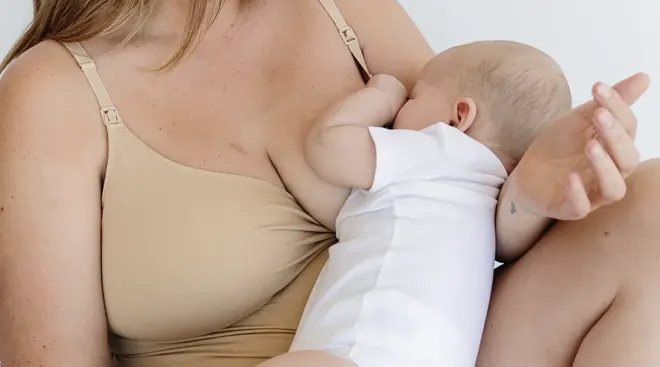What Are Montgomery Glands—and How Do They Help With Breastfeeding?
You already know that your breasts are going to transform during pregnancy. For starters, they’ll get significantly larger—but there’s more to it than that. You may also notice that the appearance of your areolas start to change. Not only will they get darker, they may also become bumpy, due to the evolution of your Montgomery or areolar glands. While Montgomery glands look relatively small, they actually play a big role in breastfeeding. Ready to learn how they help encourage the process? Read on for the lowdown on Montgomery glands.
Montgomery glands are small oil-producing glands on tiny hair follicles of the areola (the darker skin surrounding the nipple). You might also see them referred to as Montgomery tubercles or areolar glands; some doctors prefer using this latter anatomical phrase over the original term named after William Fetherstone Montgomery, the obstetrician who first described them.
Montgomery or areolar glands don’t magically emerge during pregnancy. “[They’re always there. They just become more prominent,” says Gail Herrine, MD, an ob-gyn and professor of clinical obstetrics, gynecology and reproductive science at the Lewis Katz School of Medicine at Temple University.
You can expect to see up to about a dozen of these goosebump-like glands on each nipple, says Rebecca Walker, MSN, CNM, IBCLC, a practicing midwife, certified lactation consultant and founder and CEO of BestFeeding Lactation and Feeding Consultation in Philadelphia. That said, the size and number of Montgomery glands vary from person to person.
Your breasts always have Montgomery glands—you just likely won’t notice them until the first trimester of pregnancy, along with the many other significant breasts changes. These changes may actually be visible pretty early on: Roughly half of people experience pronounced areolar glands as an early sign of pregnancy, even before a missed period or positive pregnancy test, says Walker—although you may or may not notice these changes with your naked eye. “They tend to become more raised when the nipple is stimulated by touch or temperature changes, as well as hormones in pregnancy that promote breast/chest tissue production to prepare for lactation,” she adds.
Outside of pregnancy, Montgomery glands can become more prominent if a cyst develops because the gland becomes blocked, according to the National Library of Medicine. Cysts may appear as breast lumps that may or may not be painful, red or swollen. Usually, these clogs resolve on their own within 60 to 90 days, says Walker. That said, it’s a good idea to see your doctor about any unusual lumps on your breast. Also check in if you notice signs of infection, including pain, redness, heat, swelling, inflammation, drainage, fever or body aches, as you may require antibiotics.
“During pregnancy, the areolar gland can become more pronounced, as it has an important purpose for breast/chest feeding,” says Walker.
For starters, they secrete a waxy substance with antibacterial properties that lubricates the nipple and helps it maintain the right pH balance, notes La Leche League. “”[This] eases latch when feeding, as well as releases a pheromone that helps guide baby to promote latching,” adds Walker. Research suggests that the substance has a smell similar to that of vernix caseosa—the waxy substance that covers baby’s body during pregnancy. " It helps the baby find the breast," reiterates Herrine. “[That’s why] we try not to wipe their hands off [when baby is born]. We want them to still have some of the vernix on them, so they can better find the breasts, with an alert and awake mom to help.”
Finally, Montgomery glands play a role in the immune response to potential infections. Baby’s saliva sends signals to the areolar glands that cause the lactating parent’s body to produce customized antibodies in their colostrum and milk. For example, if baby comes into contact with a sick baby at daycare, “baby’s saliva tells the lactating parent’s body what type of antibodies they need to help reduce or prevent sick symptoms—and the lactating parent will have those same antibodies floating through their body to hopefully prevent them from getting sick too,” says Walker.
We all have sebaceous glands throughout our bodies that can become clogged. On your face, for example, this can lead to pimples. Areolar glands can similarly become clogged when the substance they produce isn’t properly released, leading to swelling and other symptoms.
Overzealous use of nipple creams can cause clogging, if they don’t allow the glands to breathe, says Walker. Clogging can also occur if skin cells can get caught in a Montgomery gland, or if tight-fitting clothing doesn’t allow the skin to breathe, adds Herrine.
To clear a clogged gland, use a warm compress or soak the breast in saline water, then gently massage the area to help open the gland and encourage the substance to come out. Just avoid picking or squeezing the bumps, warns Herrine, as this can do more harm than good (and possibly lead to infection).
If Montgomery glands remain clogged after more than a day or two of home treatment, or if you have symptoms of infection (heat, redness, swelling, fever, body aches, etc.), Walker recommends checking in with your doctor. You may require antibiotics or a simple procedure to unclog the gland.
Preventative care can go a long way too. During pregnancy and while breastfeeding, it’s best to leave your Montgomery glands alone. Avoid scrubbing your nipples or using special soaps, which may simply dry out your skin. Also skip using creams and ointments (like Lanolin) on your nipples unless they’re absolutely necessary, since using products excessively may clog your Montgomery glands. “In general, I would always say try to use as little as needed,” advises Herrine. If your nipples are sore, dry or cracked from nursing, try spreading a bit of breast milk over the skin at the end of each breastfeeding session.
Montgomery glands typically shrink and become less visible on their own soon after pregnancy, if you’re not breastfeeding. If you are breastfeeding, they’ll likely diminish once your journey is over. That said, Montgomery glands may not always revert to their pre-pregnancy state. If they don’t go away and you find them bothersome, talk to your doctor; a minor cosmetic procedure might be an option.
As with many other physical transformations during pregnancy, changes to your Montgomery glands may seem unusual and even perplexing. But remember, they serve an important purpose for you and baby—so try to shift your focus on the awe-inspiring natural powers of your body.
About the experts:
Gail Herrine, MD, is an ob-gyn and professor of clinical obstetrics, gynecology and reproductive science at the Lewis Katz School of Medicine at Temple University and the postpartum medical director at Temple University Hospital in Philadelphia. She earned her medical degree from Jefferson Medical College, Thomas Jefferson University, Philadelphia.
Rebecca Walker, MSN, CNM, IBCLC, is a practicing midwife, certified lactation consultant and founder and CEO of BestFeeding Lactation & Feeding Consultation in Philadelphia.
Please note: The Bump and the materials and information it contains are not intended to, and do not constitute, medical or other health advice or diagnosis and should not be used as such. You should always consult with a qualified physician or health professional about your specific circumstances.
Plus, more from The Bump:
Navigate forward to interact with the calendar and select a date. Press the question mark key to get the keyboard shortcuts for changing dates.




















































